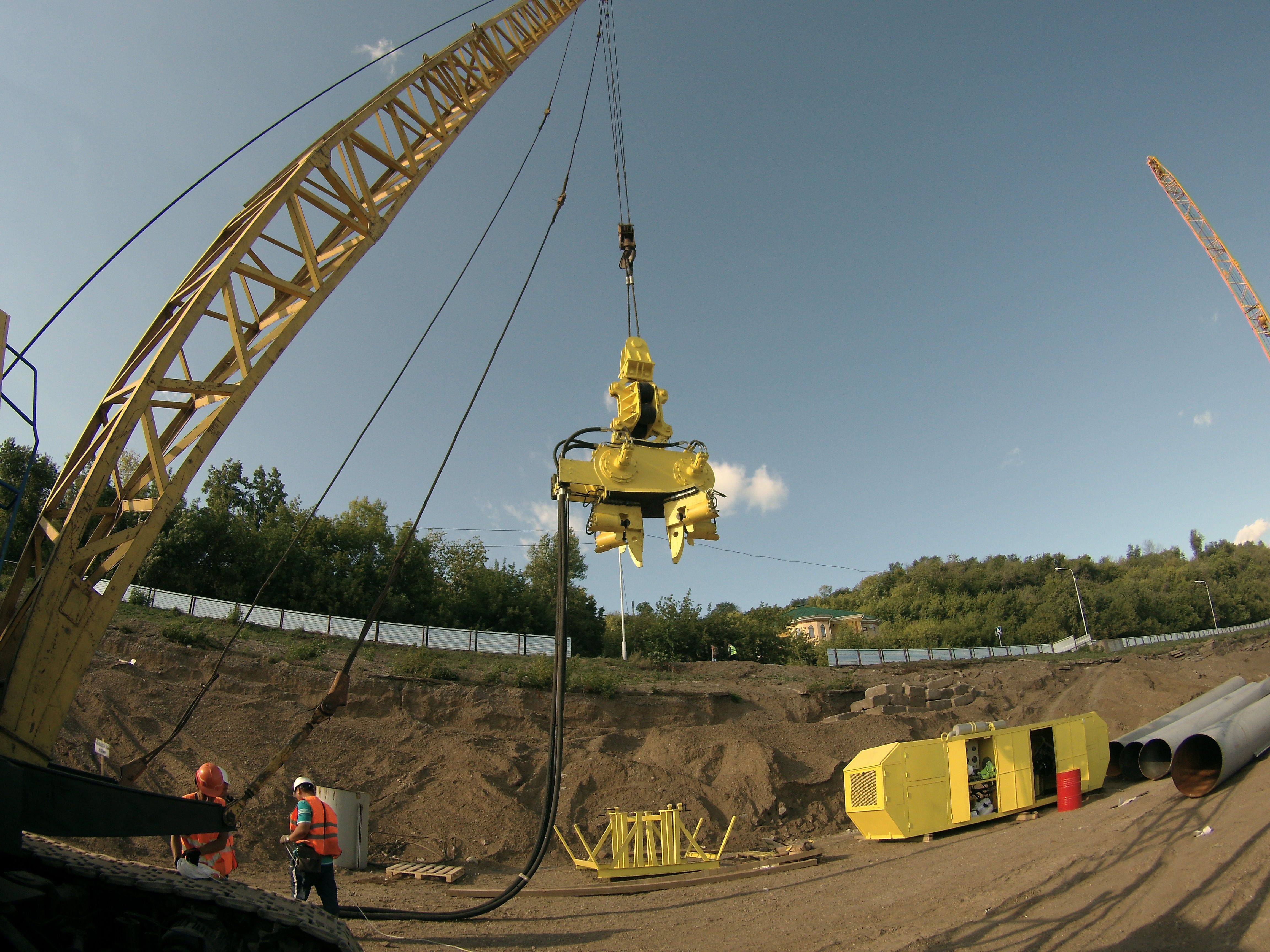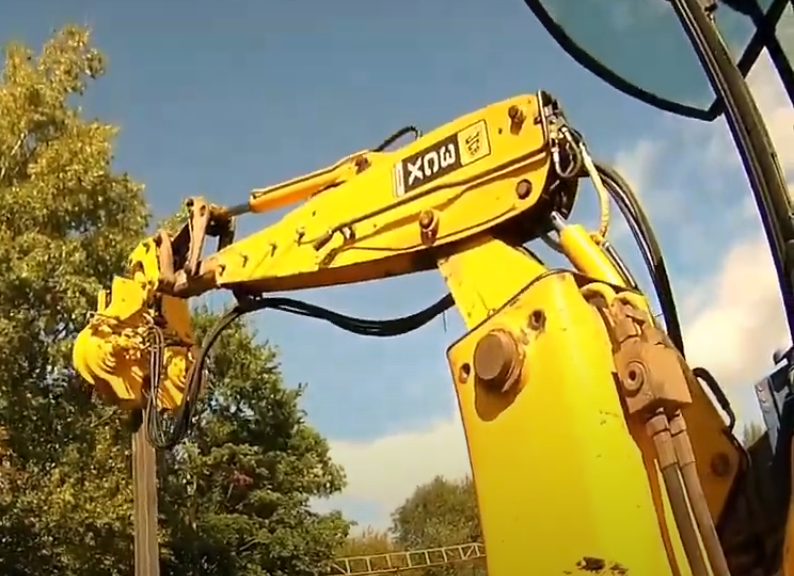In the world of heavy civil construction, time is money. When you’re driving foundation piles on a job site, delays can cascade across the entire project — affecting everything from concrete scheduling to final inspections. That’s why contractors working in marine, bridge, and utility foundation projects are turning to vibratory hammers to accelerate their timelines.
In this guide, we break down how vibratory hammers work, where they outperform traditional impact hammers, and what kind of efficiency gains you can expect on your next job.
What Is a Vibratory Hammer?
A vibratory hammer is a hydraulic machine used to install piles into the ground by applying vertical vibrations at high frequency. Instead of relying on repeated, forceful impacts like diesel or air hammers, vibratory hammers use oscillating motion to reduce soil resistance and allow the pile to sink more efficiently.
How It Works:
- The hammer clamps onto a pile (pipe, H-beam, sheet pile, or casing).
- It vibrates at 1,200–2,400 cycles per minute, transferring energy into the soil.
- These vibrations reduce soil friction around the pile.
- Gravity and the vibration allow the pile to penetrate the ground with far less force than traditional methods.
This means you’re not pulverizing your way through soil, but instead resonating through it — and that distinction leads to major time savings.
Why Are Vibratory Hammers Faster?
Let’s be clear: impact hammers have their place. But when the job calls for speed and efficiency, vibratory systems often win. Here's why:
1. Continuous Pile Motion
Impact hammers strike a pile, pause, then strike again. With each hit, the pile rebounds slightly, wasting energy and requiring repositioning. Vibratory hammers apply constant downward energy, keeping the pile in near-continuous motion. That eliminates downtime between strokes.
2. Faster Setup
Most vibratory hammers come with adjustable clamps that grip multiple pile sizes without needing to swap components. That means faster setup between piles and less time spent aligning equipment.
3. Minimal Rebound and Refusal
In variable soil types — especially silt or layered marine environments — impact hammers often experience pile bounce or refusal. Vibratory hammers maintain consistent pressure, even in transitioning soils, reducing stoppage.
Measured Time Savings in the Field
Contractors using vibratory hammers on bridge abutments and bulkhead walls have reported installation rates up to 3X faster than traditional equipment.
Example: A crew installing 10-inch steel pipe piles in coastal South Carolina was averaging 25 minutes per pile using a diesel hammer. After switching to a midsize hydraulic vibratory hammer, they reduced install time to 8 minutes per pile. That’s a 68% reduction in drive time.
Multiply that over 100 piles?You’re saving more than 28 hours on install time alone — not counting crane rental, labor, or staging gains.
Soil Types Where Vibratory Hammers Excel
Vibratory systems are especially effective in:
- Granular soils (sand, gravel, silt)
- Loose fills and reclaimed land
- Tidal flats and soft marine sediments
- Urban fill zones where soil variation is high
Because vibration temporarily fluidizes the soil, the pile faces less skin friction and can be driven rapidly without excessive force. That means less risk of pile deformation and smoother install.
In contrast, extremely dense clay or bedrock zones may still require pre-drilling or impact driving for final penetration — but vibratory hammers can often start the work faster and finish it cleaner.
Operational Efficiency: Fuel, Labor & Equipment Wear
Vibratory hammers not only install faster — they also help reduce total jobsite costs:
Lower Fuel Use
Because pile times are shorter and energy transfer is more direct, hydraulic vibratory hammers burn significantly less fuel per installed foot than diesel hammers.
Less Equipment Fatigue
Impact hammers place tremendous shock on both the pile and the machine. Over time, that translates to more breakdowns, cracked welds, and hydraulic repairs. Vibratory units operate smoothly, extending the service life of both the hammer and the crane.
Reduced Labor Hours
Fewer hours on-site means fewer overtime claims, lower per-diem costs, and more accurate scheduling. For jobs in sensitive or remote environments, this can also reduce permitting restrictions tied to noise, vibration, or public disruption.
Ideal Use Cases for Vibratory Hammers
You’ll get the biggest time savings when using vibratory hammers in the following types of projects:
1. Marine and Waterfront Construction
Docks, piers, sheet walls, and underwater piles all benefit from vibration-driven installs. Vibratory hammers work well underwater and cause less disruption to aquatic life, helping meet environmental regulations.
2. Urban Infill and Tight Access Zones
In city settings, noise and vibration complaints can delay progress. Vibratory units generate less ground shock and fewer decibels, making them better suited for constrained job sites.
3. Temporary Works and Removal Projects
Need to install sheet piling for excavation support? Vibratory hammers are not only faster at install — they’re also excellent at extraction, cutting your de-mobilization time in half.
Pros & Cons: Vibratory vs. Impact Driving
Here’s a clear side-by-side to help decision makers:
| Feature | Vibratory Hammer | Impact Hammer |
|---|---|---|
| Install Speed | High – continuous drive | Moderate – step-by-step |
| Fuel Efficiency | Moderate to high | Lower due to longer operation time |
| Equipment Wear | Minimal shock – low maintenance | High shock – frequent maintenance |
| Soil Compatibility | Best in sand/silt/fill | Best in dense clays or rock |
| Environmental Compliance | Quieter, fewer decibels | Loud, higher vibration footprint |
| Removal & Reuse | Excellent for temporary installs | Poor – piles often deformed |
Verdict: For most light-to-medium foundation projects, vibratory hammers win on speed, cost, and safety.
Safety Considerations: Fast Doesn�’t Mean Risky
Speed is important — but not at the expense of crew safety. Fortunately, vibratory hammers offer several built-in advantages:
- Remote operation from a control panel or cab
- Quick-release clamps reduce operator handling
- Lower noise levels mean less need for hearing protection
- Minimal pile kickback reduces rig movement
When combined with jobsite planning, PPE, and trained personnel, vibratory systems are not only faster — they’re safer and easier to control.
Frequently Asked Questions
Not ideal. In dense rock, you may need pre-drilling or impact assistance for final seating.
Most are hydraulic, powered by a diesel or electric power pack connected to your crane or excavator.
No — most units allow for variable frequency and clamp pressure, giving operators excellent control in the field.
Yes. Because they don’t deform the pile, vibratory hammers are preferred for temporary shoring or sheet wall applications.
Faster Projects, Greater Control
Time is one of your most expensive resources on a construction site. If you can trim 20–30% from your foundation timeline — without sacrificing quality — you’re already ahead.
Vibratory hammers offer that edge. With the right soil, setup, and crew, they can transform your install speed, reduce your operating costs, and help you win more competitive bids.
Talk to the Experts at PileDrivingUSA
Want to learn which vibratory hammer model is right for your next job?
Whether you're building a seawall in Florida or a temporary sheet pile wall in Chicago, our experts can help. Request a quote or consultation now and stay ahead of your construction schedule.



